TeachingBooks.net is delighted to welcome award-winning author Sy Montgomery as our featured guest blogger.
Each month, we ask one distinguished author or illustrator to write an original post that reveals insights about their process and craft. Enjoy!
“Chasing Cheetahs”
by Sy Montgomery
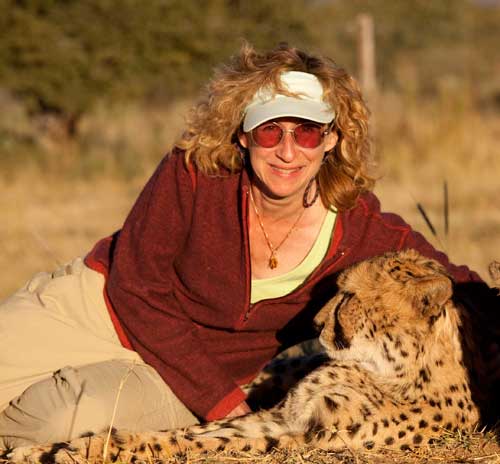
Photos © Nic Bishop
Working with Nic Bishop on a “Scientists in the Field” book always entails thrilling moments. Together, with the men and women whose work we chronicle, we’ve handled wild tarantulas in French Guiana, walked among 18,000 slithering snakes in Canada, and traveled on Bactrian camels in Mongolia in search of snow leopards.

But our last expedition was one of the most dramatic. Researching Chasing Cheetahs (HMH, 2014), we ventured into the thorny bush and golden savannah of Namibia, following young cheetahs on the hunt.
“Watch out for warthog holes!” researcher Ryan Sucaet warned us. “And thorns!” cautioned Laurie Marker, the founder of Cheetah Conservation Fund (CCF). “And snakes!” added Rachel Shairp, another of Laurie’s assistants.
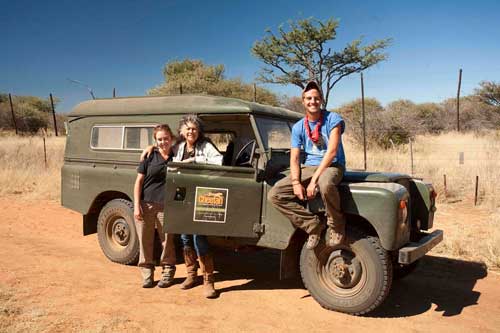
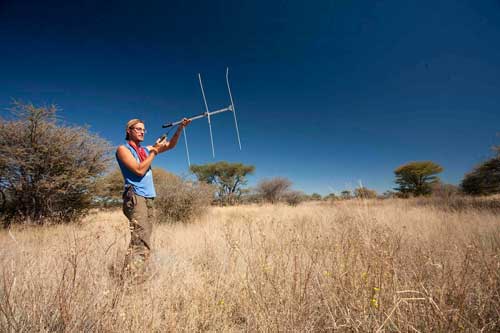
Along with warthogs, cheetahs, and a number of other animals, 12 species of poisonous snakes live in the area; in fact, Nic and I met a puff adder the day before—a handsome creature that can inject prey with potent venom from its hinged fangs.
As we walked, Ryan swung the radio telemetry antenna in a wide arc. He was tuned to the frequency of the radio collar worn by Bella, a five-year-old cheetah. “We’re definitely getting closer,” he told us. “This is near where she caught the steenbok on her fourth day out,” Rachel noted. “Maybe she’s caught something—all of her kills were made near this road.”

We hoped so. Bella, like the other felines at CCF Namibia compound, was captured by a local farmer. After killing the cub’s mother, the farmer confined Bella to a chicken coop. CCF staff rescued the animal, as they have hundreds of other orphans. “Most of our cheetahs witnessed their mothers being shot and have spent their most of their lives in captivity,” Rachel explained. “To be out in the wild again can be an adjustment.”
For this reason, Laurie and her team were out checking on the animal. The Namibia compound offers cheetahs an opportunity to learn the skills that their mothers would have taught—lessons cut short by a gun. These orphaned creatures hone their hunting skills under the watchful eyes of animal rescuers in an enormous enclosure that CCF has set up.
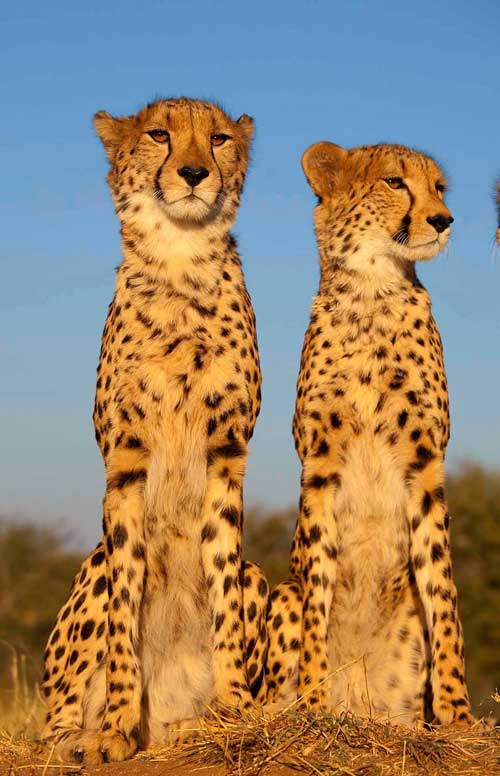
Rescuing, rehabilitating, and releasing the most vulnerable big cats in Africa is only part of the story Nic and I came to tell in our book; it’s a multilayered story with surprising twists and turns. Living with the CCF staff, we discovered that cheetah conservation means working with more than one species, in more than one country, and in touch with local residents and scientists from a range of disciplines. It’s about chemistry and genetics, veterinary medicine, and ecology. It’s about changing the farming system in Africa. It’s about working to educate kids in schools. Thanks to dedicated staff of the CCF, there’s hope that the world’s fastest land mammals will survive in the wild.
But the moment that perhaps best illustrated the hopes and challenges of CCF’s work came the day Nic and I were walking with Laurie and her assistants in the bush. Suddenly Laurie stopped short. “Oh—there she is!” And just 20 yards ahead, we saw Bella, sitting beneath a camel thorn acacia.
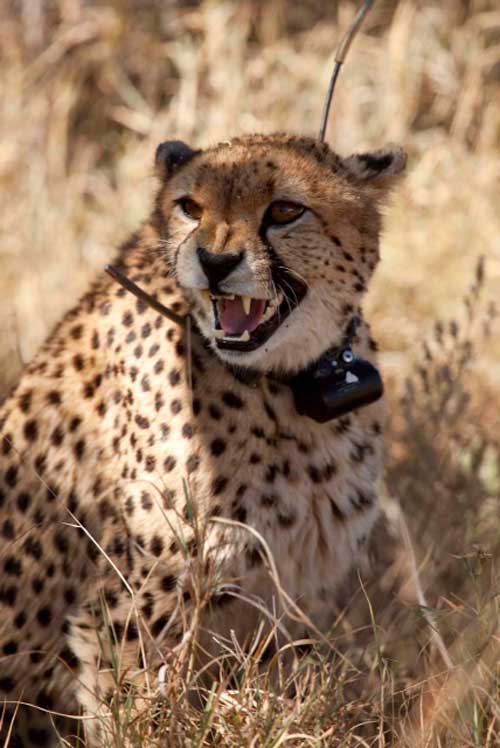
The beautiful, 70-pound cat rose to her feet. She stared into our faces with her high-set, enormous eyes. Bella’s intense, orange gaze seemed to sweep over the savannah like light from a sunset. And surely, I thought, that gaze is taking it all in; no other land mammal’s vision is so sharp.
Only then did we spot the three-inch wound in Bella’s left shoulder. Ryan explained this was probably from the tusks of an angry warthog, whose baby the cheetah had been hunting the week before. The wound was healing nicely. For Bella, says Ryan, “it was a lesson learned.”
After checking in on Bella, we were off to find Padme. That cheetah, another female, had made fewer kills than Bella, and Laurie was worried about her. We drove north along the track. Padme’s signal was strong. “She’s got to be right in here…” said Laurie. We got out of the car and made our way through the holes and the thorns. Then, there was Padme, sitting, peering out at us from behind a termite mound, about 25 feet away.
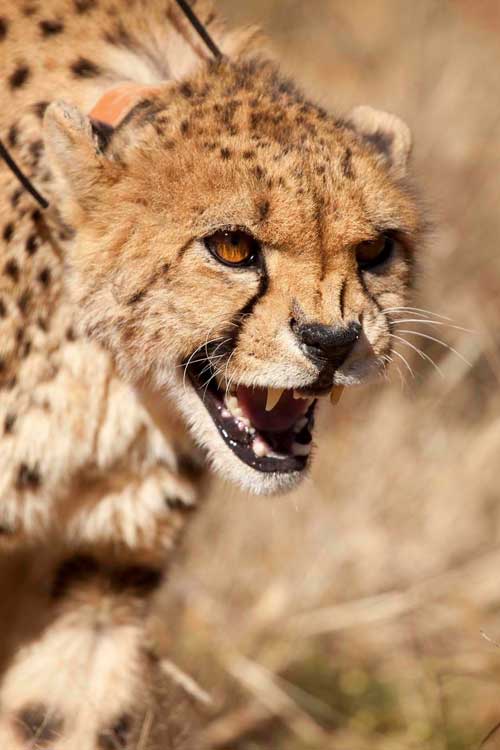
She stood, moaned, and came toward us. She didn’t appreciate that Nic and I, two strangers, were with the group. Padme peeled back her lips to hiss and snarl. She stopped 10 feet from us. We backed away—and allowed this magnificent feline to continue her hunt. If she was going to eat meat that day, she was going to have to capture it. “Not every one of these cheetahs will be able to survive on their own in the wild,” noted Laurie. Those who can’t survive on their own become ambassadors for wild cheetahs, and these ambassadors are able to live long, healthy lives in the large pens at CCF. “But at least,” adds Rachel, “they’re getting a chance to give the wild a try.”

 Listen to Sy Montgomery introduce and pronounce her name.
Listen to Sy Montgomery introduce and pronounce her name.
See all available resources for Sy Montgomery
 Listen to Nic Bishop introduce and pronounce his name.
Listen to Nic Bishop introduce and pronounce his name.
See all available resources for Nic Bishop
This material may not be used without the express written consent of Sy Montgomery.
All photos © Nic Bishop.

Leave a Reply